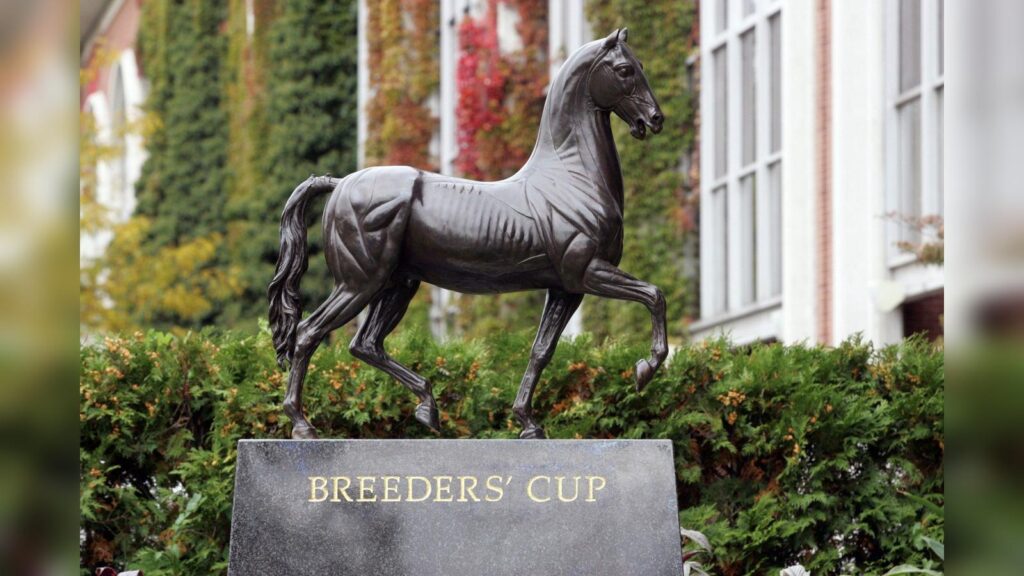A Look At The Breeders' Cup World Championships

Promo Code: BOOKIES
Must be 21+ to participate (18+ in KY). Gambling problem? Call 1-800-GAMBLER (CO, IL, IA, KY, KS, LA, MD, NC, NJ, OH, PA, TN, VA). Call 1-800-NEXT-STEP (AZ). Call 1-800-9-WITH-IT (IN). CALL 1-877-770-STOP (LA). Must be present in LA (select parishes). Licensee partner Amelia Belle Casino. Deposit required. Paid in Bonus Bets. Bets wager excluded from returns. New Customer only. T&Cs, time limits and exclusions apply.
A place where the millionaires mingle, racing royalty rub shoulders, the equine elite do battle and plenty of money is wagered at horse racing betting sites, the Breeders’ Cup attracts the best of what flat racing has to offer from around the globe every year. Competing over two tantalising days of action at a chosen US track, owners and trainers of the world’s greatest horses compete in 14 races for a share of a purse worth more than $30 million.
The original Breeders’ Cup was the brainchild of leading owner and breeder of the time, John R. Gaines, and in 1984 that dream became a reality, with the inaugural running taking place at the now demolished Hollywood Park Racetrack. Despite some unrest and trepidation from within the industry, the Breeders’ Cup became an instant hit, particularly with the larger owners and breeders in the US, and its popularity would quickly spread to all corners of the world with Breeders' Cup betting becoming a huge business in the US and beyond.
The huge prize money on offer proved to be too much to ignore for breeders, owners, trainers and jockeys from elsewhere in the world, particularly in Europe where the now regular trend of sending the best horses abroad for the world’s most lucrative races became more and more popular. This has also ensured that the best betting apps will often have enhanced offers and free bets leading up to the given its magnitude in the racing calendar now.
As the name suggests, it was the breeding industry that laid the foundations for the event, and it continues to be the main driving force behind it, generating the huge prize money on offer from the nominations of stallions and their subsequent progeny. So, how does it all work? It can be confusing for some, so let’s have a quick look and try to understand where the money comes from and where it could possibly end up.
Firstly, and most importantly, all horses that compete at the Breeders’ Cup World Championships must have been nominated for the event from an early age. Any breeding establishment wishing to have their horse’s progeny eligible, must nominate their sires on an annual basis. Each nomination costs breeders the advertised fee of their horse for that covering season, and all progeny from that season are then automatically eligible for nomination as a foal.
Once foals are nominated once, they become eligible to compete in the Breeders’ Cup throughout their careers. Given that the cost of nomination for these youngsters is a one off $400 payment, the returns for breeders can be massive, particularly as horses with nominations to their names fetch far greater prices when put through the sales ring.
Stallions and mares standing in other nations across the globe are also granted access to Breeders’ Cup nominations. European nominations and all of those from northern hemisphere countries must pay 50% of that season’s stud fee, while in the southern hemisphere, breeders must fork out 25%. This is a huge incentive for the world’s largest breeding operations to take part. Irish and British breeders in particular have taken advantage of the half price nomination fee – leading to more runners and subsequent winners from the likes of the Coolmore breeding juggernaut and their trainer, Aidan O’Brien.
Which Horses Get to Run at The Breeders’ Cup?
The Breeders’ Cup is a world-renowned, money-laden competition, and as such, it is only natural that a strict qualifying system is in place to make sure only the best of the best will be on show. Although many dream big, the Breeders’ Cup remains just that – a dream. With the type of owner/breeder operations and their seemingly bottomless pockets involved in the flat racing industry, the one thing you will rarely come across is an underdog tale. The layperson will likely have to sit, watch and continue to dream.
‘Win and you’re in’ sounds simple enough, right?
The first way of qualifying for the Breeders’ Cup comes in the form of challenge races, where if you win, you’ve done enough to qualify. On paper, that may seem like a reasonable possibility, but factor in the quality of the qualifying races, and it becomes a wholly different story.
The best Grade 1/Group 1 races worldwide are used as a means of qualifying for the Breeders’ Cup. There are qualifying races all over the world, including South Africa, Japan, Brazil, Australia and even Peru. Those in the US and Europe tend to be the most prestigious qualifying races take place.
For example, Royal Ascot plays host to a number of qualifying races throughout the meeting, with the Queen Anne Stakes, the Prince of Wales’ Stakes, the King’s Stand and the Norfolk all providing instant access to the Breeders’ Cup for the winners.
France’s Prix de l’Arc de Triomphe and Prix Morny, Ireland’s Champions Stakes, Moyglare Stakes and Matron Stakes are also qualifiers, so it quickly becomes apparent the type of equine excellence we are dealing with for the world’s richest two-day meeting.
Second and Third Chances to Qualify
For those connections not fortunate enough to win a qualifier, a second chance comes in the form of a points system for performances in the world’s biggest races. Horses that may have won a Grade 1 not in the qualifying list will receive 10 points, those placed in any Grade 1 receive six points, while simply running in a Grade 1 will earn them four points.
Grade 2 winners receive six, with four points for a place and two for running, and, finally, Grade 3 winners receive four, two for a place and one point for an unplaced performance. The more points accumulated, the more chance of qualifying for the Breeders’ Cup.
The final safety net for top-class horses that may not have accumulated enough points, or may have had an unlucky or disrupted season, comes in the form of selection from a panel of experts. This panel has the unenvious job of ranking those horses not meeting the first two criteria, as connections hope for last-minute inclusion.
In the main, Breeders’ Cup races have a total of fourteen runners allowed. The first seven horses qualifying through either the challenge races, or the points system will automatically make the line-up, whilst any remaining entries up to and over the fourteen runner limit will be ranked in order of preference by the aforementioned panel. Simple, right!
Now we have covered the ins and outs of getting to the Breeders’ Cup, I think it is about time we have a look back at some of the more memorable moments from years gone by, particularly when European raiders have caused quite a stir across the Atlantic.
Breeders’ Cup's Most Memorable Moments
Let’s start with the wonder mare, Enable, who has well and truly stamped her name firmly into the racing annals, including with a special victory in the 2018 Breeders’ Cup Turf. It takes a very special specimen to win both the English and Irish Oaks, but Enable trounced her fellow sex with such ease in those races, thus proving that the Juddmonte Farms-owned mare was indeed just that – very special.
The final start of her three-year-old campaign in 2017 saw her announce herself on the world stage with victory in the Prix de l’Arc de Triomphe, and to prove that this was no fluke, Enable returned to the French capital 12 months later to successfully defend her crown.
It was little wonder, then, that US fans waited with bated breath as soon as it was known that the brilliant mare would be taking her chance in the Breeders’ Cup the following month. It was a brave decision by connections to send the then-four-year-old over so soon, but it paid off.
Fans were treated to a performance full of both beauty and brawn, as Enable battled her way to a three-quarters-of-a-length victory from fellow European raider, Magical. To put in a performance of this nature just a month after winning the ‘Arc’ was stunning. This would be Enable’s sole start at the Breeders’ Cup, but the nature of her victory on that day still holds a special place in many hearts.
From years earlier, another British-trained mare, Ouija Board, also awakens fond feelings when thinking of the Breeders’ Cup. Ed Dunlop’s charge, has more stamps on her passport than many frequent fliers due to her globetrotting exploits, but she always seemed to save a little bit extra to perform in front of her US fans in the Breeders’ Cup Filly and Mares.
Ouija Board, like Enable, was an English and Irish Oaks winner, and also attempted to win the Arc in 2003, ultimately finding traffic trouble before finishing in a blaze to just be denied. However, just 27 days later, Ouija Board paraded herself in front of the Breeders’ Cup crowd, powering clear to win the Breeders’ Cup Filly and Mares by one-and-a-half lengths under Kieran Fallon. This was just the beginning of the mare’s love affair with the Breeders’ Cup.
Twelve months later, Ouija Board, returned to defend her crown, and although she couldn’t reel in the winner on that occasion, her stature as a fans’ favorite continued to grow. Fast forward another year and the then-five-year-old, stepped out on to the famous turf of the Churchill Downs Racetrack and went in search of redemption.
Ouija Board once again put on quite a show for her fans worldwide. She easily reclaimed her title in the Breeders’ Cup Filly and Mares, forging home to win by two-and-a-quarter lengths, this time under Frankie Dettori.
Europe’s finest
Obviously, Britain is not the only country to have sent heroes to do battle at the Breeders’ Cup, and so it would be impossible to say anything about the history of the Breeders’ Cup, without mentioning the fabulous French mare, Goldikova.
Still the only horse to win the same Breeders’ Cup race on three occasions, the Freddy Head-trained mare was just a three-year-old when she won the first of her Breeders’ Cup Mile titles at Santa Anita in 2008. The same track played host to her double attempt the following year, and although she left it very late on this occasion, she hit the line just in time to defend her crown.
The historic hat-trick was brought up a year later in 2010, this time at Churchill Downs. Despite being bumped around early, regular jockey, Olivier Peslier, took no chances this time and allowed Goldikova to stretch her head out in the final furlong to win going away. The reaction in the stands was incredible. A horse had just won three Breeders’ Cup Mile races in a row, and a mare no less! Incredibly, Goldikova returned again the following year and was just one length away from winning the race for a fourth time after being caught late.
Ireland has Great History in the Breeders’ Cup
Of course, one country that cannot be ignored when it comes to the Breeders’ Cup is Ireland and in particular, the amazing O’Brien family of Ballydoyle. Aidan and his family have enjoyed unrivalled success across the globe, but one race that must hold a special place within team O’Brien is the 2011 Breeders’ Cup Turf.
Leading up to the Breeders’ Cup, there had been mutterings of discontent and unhappiness that Aidan had been using his young son, Joseph, as his number one jockey. It was a huge decision by the master of Ballydoyle to put so much pressure on one so young, but O’Brien Sr. stuck to his guns, and Joseph, to his credit, carried on with his job with a professional attitude far beyond his tentative years.
St Nicholas Abbey, would be the horse to put to bed any doubts about Aidan’s decision, or rather, Joseph’s cool and collected ride on said horse.
Sent off a 5/1 shot, St Nicholas Abbey was rather overlooked in the horse racing betting market on the day, which was understandable after an indifferent season, including two defeats under Joseph. One of these was the King George VI and Queen Elizabeth Stakes at Royal Ascot, a race in which the jockey left his mount with far too much to do in the closing stages.
There would be no poor decision making or bad timing at Churchill Downs, however. Joseph scratched his boots along the track’s inside hedge for much of the race, before steering St Nicholas Abbey to the outside where he quickly picked up and powered by his tiring opponents to win by a going away two-and-a-quarter lengths.
It was a fabulous performance from both the horse and his jockey, and the vision of St Nicholas Abbey’s white-starred face coming into clear view for the first time down the straight is something that still remains in the mind’s eye even after all these years.
The reaction of the O’Brien family in the parade ring was one of huge emotion. Tears flowed, hugs tightened and pride filled the hearts of the whole clan. The critics had been answered, Aidan and his owners had been justified and, of course, there was also the small matter of Joseph having just become the youngest jockey to ever win at the Breeders’ Cup at the age of 18 - a record that still stands to this day. Incredibly, Joseph also went on to become the youngest-ever trainer to win at the Breeders’ Cup just eight years later.
That story, among others, is what the Breeders’ Cup is all about. Yes, there is huge money on the line both for the competitors and those watching along on horse racing betting apps. Yes, the world’s greatest horses, trainers and jockeys are on view. But most of the time there are also stories behind the successes and failures throughout all of the years. Stories of surprise, adversity, brilliance and emotion. Horse racing is supposed to elicit emotion from everyone involved, and the Breeders’ Cup is one place that will never let you down on that front.
About the Author

Adam has worked in online betting for pretty much his entire adult life. Having spent over a decade working for some of the biggest betting sites and online casinos in their operations and content teams, NFL, soccer and horse racing are Adam's main focuses, but there's always room for him to cast his eye over a new slot game or casino.

 Robocat New Customer Welcome Offer CanadaJanuary 2026: 100% Welcome Bonus up to $750 + 200 Free Spins
Robocat New Customer Welcome Offer CanadaJanuary 2026: 100% Welcome Bonus up to $750 + 200 Free Spins  888casino New Customer Promo Code CanadaJanuary 2026: 100% Welcome Bonus up to $1,000 + 200 Free Spins
888casino New Customer Promo Code CanadaJanuary 2026: 100% Welcome Bonus up to $1,000 + 200 Free Spins  bet365 Bonus Code BOOKIES: Get $150 Bonus on Ravens vs Steelers on Sunday Night Football (Jan. 4)
bet365 Bonus Code BOOKIES: Get $150 Bonus on Ravens vs Steelers on Sunday Night Football (Jan. 4)  Caesars Sportsbook Promo Code BOOKIES250BM: Get up to $250 Bonus for Ravens vs Steelers (Jan. 4)
Caesars Sportsbook Promo Code BOOKIES250BM: Get up to $250 Bonus for Ravens vs Steelers (Jan. 4)  Fanatics Sportsbook Promo: Get up to $2k in FanCash for Ravens vs Steelers (Jan. 4)
Fanatics Sportsbook Promo: Get up to $2k in FanCash for Ravens vs Steelers (Jan. 4)  FanDuel Promo Code: Get $250 Bonus for Ravens vs Steelers (Jan. 4)
FanDuel Promo Code: Get $250 Bonus for Ravens vs Steelers (Jan. 4)
Comments